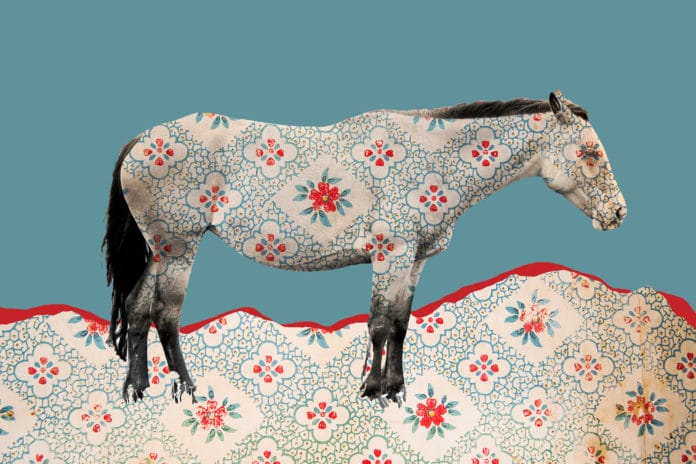Featured Artwork: Miles Glynn presented by Creighton Block Gallery
Horse No. 16
26 x 39 in.
Archival print on 5.5 oz. Belgian Linen
2018, edition of 25
In Wallflower Series I combine photographs I take of animals and vintage wallpapers. I travel to abandoned homesteads, gritty ghost towns, and buildings dripping with history to photograph these exquisite wallpapers – these glorious relics of an effort made by people who wished to enjoy a simple bit of beauty inside their dwelling on the harsh and hostile American frontier. But time has had its way with these buildings, and in my own way, I take comfort in helping the grace and grandeur of these relics to live on.
I photographed this horse on the Crow Reservation, near Little Bighorn Battlefield National Monument, in southeastern Montana. On this land in 1876 the infamous battle took place between native tribes of the northern plains, lead by Crazy Horse and Sitting Bull, and the U.S. Army’s 7th Cavalry, lead by General George Armstrong Custer. In this battle, known as “Custer’s Last Stand”, General Custer and every soldier of the five battalions under his command were killed. Today, upon the vast expanse of rolling hills and oceans of prairie grass, there is a heaviness that still persists. Scattered simple headstones mark the locations of the fallen native warriors, soldiers, and horses. For me, it is a place filled with contrasting solace and somberness all at once. In the stillness of the vast prairie one can not help but be moved by the significance of this place and the energy which still lingers here.
I photographed this wallpaper in the kitchen of an abandoned homestead on the northern Montana prairie along Highway 2, also known as the “Hi-Line.” The Homestead Act of 1862 provided 160 acres free to anyone who agreed to live upon and improve it for a period of five years. Though slow to stake claims at first, homesteaders eventually flooded to Montana’s northern prairie despite the harsh climate and foreboding conditions. Between 1909 and the early 1920s more than 80,000 eager homesteaders set out to “better their condition” by staking their slice of the frontier. By the late 1920’s, 60,000 of them had either packed up and left or were sent off to fight in World War I. Both farmers and ranchers had exploited the land during the wet years. They’d overgrazed, overfarmed, and spread themselves too thin. Banks sprang up and new counties were formed almost on a whim. No one realized that when the rains subsided, all that free land would come back to haunt them. Today this region is still sparse, vast, and epitomizes “Big Sky Country”. The hearty souls who live there have bettered their condition and continue to improve their land, day by day.
Artist Bio
Miles Glynn is an American artist residing in Bozeman, Montana. The son of a U.S. Army
photojournalist, Miles spent his formative years tagging along with his father on photo assignments and
learning the science and art of developing photographs in the dark room.
These early experiences and memories forged what would become driving forces in Miles’ personal and
professional life: the joy of exploring our vast country, the solace found in simple moments on the open
road, the drive to constantly move toward the next bend and beyond. With each passing mile he seeks to
reconcile the natural and man-made worlds and contextualize the effect time has had on them.
Rather than merely documenting his subjects, Miles instead aims to present his interpretation of them.
And therein lies the challenge and the art: to present unique and compelling interpretations which nobody
else viewing the same scene could create.
In Wallflower Series, Miles combines photographs of vintage wallpapers and animals. He travels to
abandoned homesteads, gritty ghost towns, and buildings dripping with history to photograph these
exquisite wallpapers from a bygone time. To him, these glorious relics portray an effort made by people
who wished to enjoy a simple bit of beauty inside their dwelling on the harsh and hostile American
frontier. But time has had its way with these buildings, and in his own way, he takes comfort in helping
the grace and grandeur of these relics to live on.
Artist Statement
Through photography I present my distinct interpretations of scenes and subjects which I find compelling.
I am most intrigued by images which offer contrast, conflicts, and contradictions: warm and cool, striking
yet soothing, familiar but curious. Perhaps the greatest conflict of all is the natural and man-made worlds
and how they have played out over time in the American West. The artwork I create is an attempt at
framing these worlds and the haunting allure that has drawn folks out West for years.
View more of Miles’ work at Creighton Block Gallery at www.creightonblockgallery.com/artist/glynn-miles/








